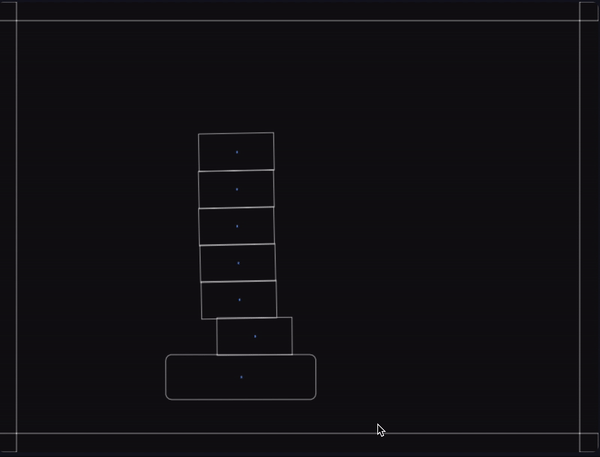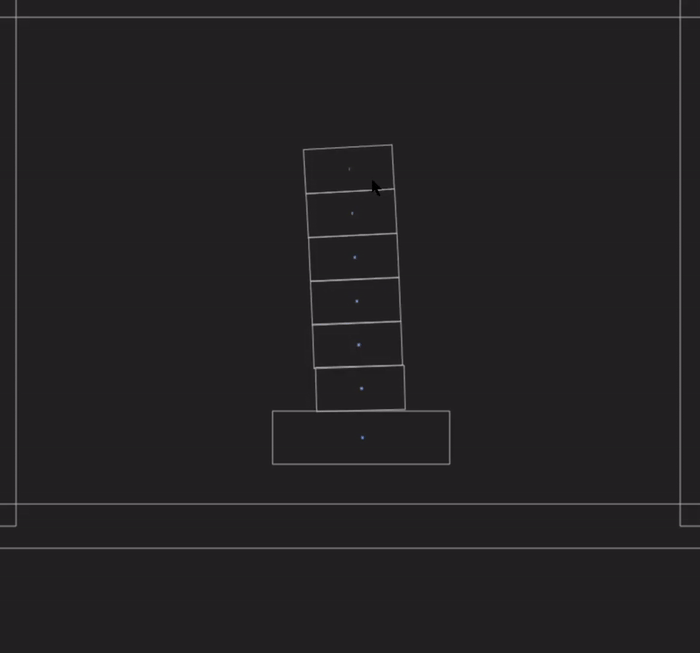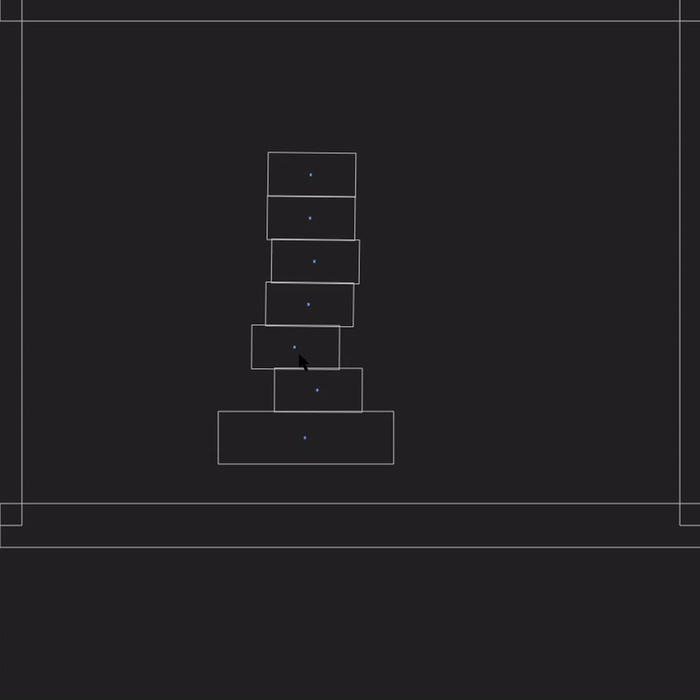window.addEventListener('load', function() {
var canvas = document.getElementById('world')
var mouseNull = document.getElementById('mouseNull')
var engine = Matter.Engine.create();
var world = engine.world;
var render = Matter.Render.create({ element: document.body, canvas: canvas,
engine: engine, options: { width: 800, height: 800,
background: 'transparent',showVelocity: true }});
var body = Matter.Bodies.rectangle(400, 500, 200, 60, { isStatic: true}),
size = 50, counter = -1;
var stack = Matter.Composites.stack(350, 470 - 6 * size, 1, 6,
0, 0, function(x, y) {
return Matter.Bodies.rectangle(x, y, size * 2, size, {
slop: 0.5, friction: 1, frictionStatic: Infinity });
});
Matter.World.add(world, [ body, stack,
Matter.Bodies.rectangle(400, 0, 800, 50, { isStatic: true }),
Matter.Bodies.rectangle(400, 600, 800, 50, { isStatic: true }),
Matter.Bodies.rectangle(800, 300, 50, 600, { isStatic: true }),
Matter.Bodies.rectangle(0, 300, 50, 600, { isStatic: true })
]);
Matter.Events.on(engine, 'beforeUpdate', function(event) {
counter += 0.014;
if (counter < 0) { return; }
var px = 400 + 100 * Math.sin(counter);
Matter.Body.setVelocity(body, { x: px - body.position.x, y: 0 });
Matter.Body.setPosition(body, { x: px, y: body.position.y });
});
var mouse = Matter.Mouse.create(render.canvas),
mouseConstraint = Matter.MouseConstraint.create(engine, { mouse: mouse,
constraint: { stiffness: 0.2, render: { visible: false }}});
var dragBody, overshoot = 0.0, threshold = 50.0, loc, dloc, offset,
bodies = Matter.Composite.allBodies(world), moveOn = true;
getMousePosition = function(event) {
var element = mouse.element, pixelRatio = mouse.pixelRatio,
elementBounds = element.getBoundingClientRect(),
rootNode = (document.documentElement || document.body.parentNode ||
document.body),
scrollX = (window.pageXOffset !== undefined) ? window.pageXOffset :
rootNode.scrollLeft,
scrollY = (window.pageYOffset !== undefined) ? window.pageYOffset :
rootNode.scrollTop,
touches = event.changedTouches, x, y;
if (touches) {
x = touches[0].pageX - elementBounds.left - scrollX;
y = touches[0].pageY - elementBounds.top - scrollY;
} else {
x = event.pageX - elementBounds.left - scrollX;
y = event.pageY - elementBounds.top - scrollY;
}
return {
x: x / (element.clientWidth / (element.width || element.clientWidth) *
pixelRatio) * mouse.scale.x + mouse.offset.x,
y: y / (element.clientHeight / (element.height || element.clientHeight) *
pixelRatio) * mouse.scale.y + mouse.offset.y
};
};
mousemove = function() {
loc = getMousePosition(event);
dloc = dragBody.position;
overshoot = ((loc.x - dloc.x)**2 + (loc.y - dloc.y)**2)**0.5 - offset;
if (overshoot < threshold) {
mouse.element.removeEventListener("mousemove", mousemove);
mouse.element.addEventListener("mousemove", mouse.mousemove);
moveOn = true;
}
}
Matter.Events.on(mouseConstraint, 'startdrag', function(event) {
dragBody = event.body;
loc = mouse.position;
dloc = dragBody.position;
offset = ((loc.x - dloc.x)**2 + (loc.y - dloc.y)**2)**0.5;
Matter.Events.on(mouseConstraint, 'mousemove', function(event) {
loc = mouse.position;
dloc = dragBody.position;
for (var i = 0; i < bodies.length; i++) {
overshoot = ((loc.x - dloc.x)**2 + (loc.y - dloc.y)**2)**0.5 - offset;
if (bodies[i] != dragBody &&
Matter.SAT.collides(bodies[i], dragBody).collided == true) {
if (overshoot > threshold) {
if (moveOn == true) {
mouse.element.removeEventListener("mousemove", mouse.mousemove);
mouse.element.addEventListener("mousemove", mousemove);
moveOn = false;
}
}
}
}
});
});
Matter.Events.on(mouseConstraint, 'mouseup', function(event) {
if (moveOn == false){
mouse.element.removeEventListener("mousemove", mousemove);
mouse.element.addEventListener("mousemove", mouse.mousemove);
moveOn = true;
}
});
Matter.Events.on(mouseConstraint, 'enddrag', function(event) {
overshoot = 0.0;
Matter.Events.off(mouseConstraint, 'mousemove');
});
Matter.World.add(world, mouseConstraint);
render.mouse = mouse;
Matter.Engine.run(engine);
Matter.Render.run(render);
});
<canvas id="world"></canvas>
<script src="https://cdnjs.cloudflare.com/ajax/libs/matter-js/0.10.0/matter.js"></script>



